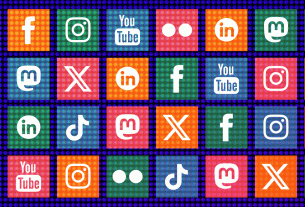At EFF, our work always begins from the same place: technological self-determination. That’s the right to decide which technology you use, and how you use it. Technological self-determination is important for every technology user, and it’s especially important for users with disabilities.
Assistive technologies are a crucial aspect of living a full and fulfilling life, which gives people with disabilities motivation to be some of the most skilled, ardent, and consequential technology users in the world. There’s a whole world of high-tech assistive tools and devices out there, with disabled technologists and users intimately involved in the design process.
The accessibility movement’s slogan, “Nothing about us without us,” has its origins in the first stirrings of European democratic sentiment in sixteenth (!) century and it expresses a critical truth: no one can ever know your needs as well you do. Unless you get a say in how things work, they’ll never work right.
So it’s great to see people with disabilities involved in the design of assistive tech, but that’s where self-determination should start, not end. Every person is different, and the needs of people with disabilities are especially idiosyncratic and fine-grained. Everyone deserves and needs the ability to modify, improve, and reconfigure the assistive technologies they rely on.
Unfortunately, the same tech companies that devote substantial effort to building in assistive features often devote even more effort to ensuring that their gadgets, code and systems can’t be modified by their users.
Take streaming video. Back in 2017, the W3C finalized “Encrypted Media Extensions” (EME), a standard for adding digital rights management (DRM) to web browsers. The EME spec includes numerous accessibility features, including facilities for including closed captioning and audio descriptive tracks.
But EME is specifically designed so that anyone who reverse-engineers and modifies it will fall afoul of Section 1201 of the Digital Millennium Copyright Act (DMCA 1201), a 1998 law that provides for five-year prison-sentences and $500,000 fines for anyone who distributes tools that can modify DRM. The W3C considered – and rejected – a binding covenant that would protect technologists who added more accessibility features to EME.
The upshot of this is that EME’s accessibility features are limited to the suite that a handful of giant technology companies have decided are important enough to develop, and that suite is hardly comprehensive. You can’t (legally) modify an EME-restricted stream to shift the colors to ones that aren’t affected by your color-blindness. You certainly can’t run code that buffers the video and looks ahead to see if there are any seizure-triggering strobe effects, and dampens them if there are.
It’s nice that companies like Apple, Google and Netflix put a lot of thought into making EME video accessible, but it’s unforgivable that they arrogated to themselves the sole right to do so. No one should have that power.
It’s bad enough when DRM infects your video streams, but when it comes for hardware, things get really ugly. Powered wheelchairs – a sector dominated by a cartel of private-equity backed giants that have gobbled up all their competing firms – have a serious DRM problem.
Powered wheelchair users who need even basic repairs are corralled by DRM into using the manufacturer’s authorized depots, often enduring long waits during which they are unable to leave their homes or even their beds. Even small routine adjustments, like changing the wheel torque after adjusting your tire pressure, can require an official service call.
Colorado passed the country’s first powered wheelchair Right to Repair law in 2022. Comparable legislation is now pending in California, and the Federal Trade Commission has signaled that it will crack down on companies that use DRM to block repairs. But the wheels of justice grind slow – and wheelchair users’ own wheels shouldn’t be throttled to match them.
People with disabilities don’t just rely on devices that their bodies go into; gadgets that go into our bodies are increasingly common, and there, too, we have a DRM problem. DRM is common in implants like continuous glucose monitors and insulin pumps, where it is used to lock people with diabetes into a single vendor’s products, as a prelude to gouging them (and their insurers) for parts, service, software updates and medicine.
Even when a manufacturer walks away from its products, DRM creates insurmountable legal risks for third-party technologists who want to continue to support and maintain them. That’s bad enough when it’s your smart speaker that’s been orphaned, but imagine what it’s like to have an orphaned neural implant that no one can support without risking prison time under DRM laws.
Imagine what it’s like to have the bionic eye that is literally wired into your head go dark after the company that made it folds up shop – survived only by the 95-year legal restrictions that DRM law provides for, restrictions that guarantee that no one will provide you with software that will restore your vision.
Every technology user deserves the final say over how the systems they depend on work. In an ideal world, every assistive technology would be designed with this in mind: free software, open-source hardware, and designed for easy repair.
But we’re living in the Bizarro world of assistive tech, where not only is it normal to distribute tools for people with disabilities are designed without any consideration for the user’s ability to modify the systems they rely on – companies actually dedicate extra engineering effort to creating legal liability for anyone who dares to adapt their technology to suit their own needs.
Even if you’re able-bodied today, you will likely need assistive technology or will benefit from accessibility adaptations. The curb-cuts that accommodate wheelchairs make life easier for kids on scooters, parents with strollers, and shoppers and travelers with rolling bags. The subtitles that make TV accessible to Deaf users allow hearing people to follow along when they can’t hear the speaker (or when the director deliberately chooses to muddle the dialog). Alt tags in online images make life easier when you’re on a slow data connection.
Fighting for the right of disabled people to adapt their technology is fighting for everyone’s rights.
(EFF extends our thanks to Liz Henry for their help with this article.)



